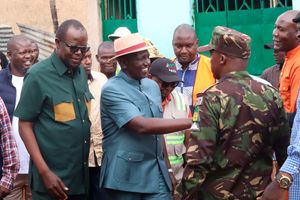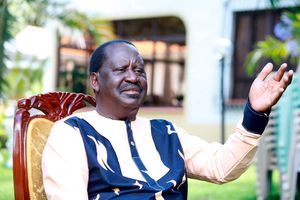
President William Ruto (left) with ODM leader Raila Odingaa (right) and Principal Secretary for Interior Raymond Omollo during the Blue Economy Summit in Homa Bay County.
Bulldozers are rumbling, cranes are swinging, and roads, housing, and infrastructure are reshaping once-forgotten villages in Nyanza—clear signs of a region undergoing an unprecedented economic revival.
Backed by a powerful alliance between President William Ruto and ODM leader Raila Odinga, more than Sh69 billion worth of development projects are breathing new life into a region that, for decades, bore the brunt of political exclusion and developmental neglect.
What began as fierce political rivalry has transformed into a working partnership now being credited with ushering in a new era of opportunity and growth.
Across the four Nyanza counties—Siaya, Homa Bay, Migori, and Kisumu—the development is widespread, but similar projects are taking root simultaneously, painting a picture of coordinated, inclusive planning.
Road construction is at the heart of the transformation, with strategic upgrades worth billions connecting trade hubs and easing rural mobility.
In Homa Bay, the Mbita–Sindo–Kiabuya–Karungu–Agolo Muok Road (Sh2.9 billion) and the Kadel–Ramba Road (Sh3.7 billion) are vital arteries being revived after years of delay.
Migori has also seen the completion of the Isebania–Ikerege–Kehancha–Ntimaru–Gitwembe–Angata Road (Sh2.86 billion), with stalled projects like the Riosiri–Moi University Road (Sh1.18 billion) and the Masara–Sori Road (Sh1.52 billion) still waiting for a push.
In Siaya, road upgrades are ongoing on the Bondo–Uyawi–Liunda, Got–Nanga–Jera Bar Ober, and Ukwala–Ugunja–Rwambwa routes at a combined cost exceeding Sh4 billion. The Ukwala–Ugunja–Rwambwa road is nearing completion at 98 percent.
Bridge construction has also picked up, with the Dho-Goye and Nzoia bridges—worth over Sh460 million—underway, although progress at Dho-Goye has stalled due to the lack of an active contractor.
Kisumu’s transformation is anchored on mega roads such as the Sh14 billion Chanan Singh–Miwani Road and the Sh9 billion Mamboleo–Great Lakes University Road, vital to the city’s ambition to become a logistics and industrial hub.
The Affordable Housing Programme—a key policy of the Ruto administration—is taking root across the region.
President Ruto has noted that Kisumu and its environs are set to reap big from 15,000 affordable housing units constructed in the first phase of the ongoing project.
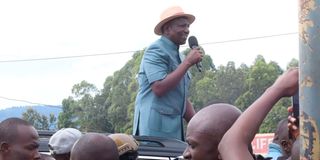
President William Ruto addresses residents of Rongo in Migori County on May 5, 2025.
Dr Ruto, in a tour of the region last week, announced that Mr Odinga had donated five acres of his family land in Kirembe area to the national government to put up more housing units.
“I thank Hon Odinga for the gesture and want to announce that the government, through the housing program, will invest a total of Sh 3.5 billion in the parcel, which will benefit close to 1000 locals,” the president said.
Mr Odinga, who accompanied the president, affirmed that he will continue to work closely with the current administration to help address challenges Kenyans are facing.
“The five-acre donation will go a long way in addressing the housing needs of locals in Kisumu and the project will have key amenities like schools and hospitals,” the ODM leader said as he lashed out at former deputy president Rigathi Gachagua over his “shareholding government narrative.”
“Each region deserves development and we cannot entertain such a kind of divisive politics,” Mr Odinga said.
In Siaya’s Alego-Usonga, 882 housing units are under construction at a cost of Sh2.5 billion, with another proposed for Ukwala AP Line.
Homa Bay is implementing a Sh227 million housing project, while Kisumu is rolling out the ambitious Sh5.7 billion Lumumba Housing Project to address the city’s housing shortfall. In Migori, housing initiatives in Mabera worth Sh182 million are under development.
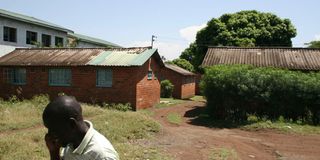
A section of Lumumba Estate in Kisumu City. The residential neighbourhood that was built by the colonial government in 1961 is set to be demolished to pave way for modern buildings under the national government’s affordable housing programme.
Homa Bay Governor Gladys Wanga, who hosted this year’s Madaraka Day celebrations, described the development in Nyanza as “historic.”
“This indeed is a game-changer for our region. Imagine the transformation: upgraded roads, an excellent stadium, and a spruced-up airstrip.
This national spotlight means immediate economic benefits for our traders, job opportunities for our youth, and legacy infrastructure that will serve generations to come,” she said.
Efforts to attract manufacturing and value addition are reflected in the creation of industrial parks and special facilities. The Siaya Industrial Park (Sh500 million), although only 1 percent complete, is part of this wider goal. In Kisumu, the establishment of the Kabonyo Fisheries and Aquaculture Training Centre of Excellence (Sh2.5 billion)—a first of its kind in Kenya—aims to train youth in fish farming and boost exports.
Once operational, President Ruto says it will produce seven million fingerlings quarterly to restock Lake Victoria and drive research, training, and innovation.
“The facility will house a Nile Perch Innovation Centre, an Aquaculture Resource Centre, and the Kenya Fishing School, positioning Kenya as a regional aquaculture leader,” President Ruto announced during Madaraka Day fete on Sunday.
The Kisumu Rivatex Go-down, symbolising a revival of Kenya’s textile industry in partnership with Eldoret’s Rivatex, is also in progress.
Water projects are expanding across Nyanza, with impressive gains in coverage. In Homa Bay, the Sh674 million Kendu Bay Water Supply and Sh1.37 billion Oyugis Water Project have already improved access.
Migori’s Last Mile Water Connectivity Project (Sh277 million) is fully complete, serving communities in Isebania and beyond. Siaya’s Ugunja–Sega–Ukwala Water Project (Sh1.04 billion) is now serving more than 91,000 people, while the Urenga Level 3 Hospital Water Project is fully operational.
Kisumu’s LVWATSAN programme (Sh1.2 billion) is enhancing the sewerage and water supply network in urban areas.
Agricultural revitalisation is evident in the Lower Nzoia Irrigation Project in Siaya—now 92 percent complete and costing Sh5 billion. It is expected to dramatically boost agricultural productivity despite some delays due to land compensation issues.
In Migori, the revival of the Gogo Hydropower Plant (Sh2.8 billion) is a strategic energy project expected to reduce load shedding and stabilise power supply in the wider Western region. The Lower Kuja Irrigation Project, worth Sh89 million and 67 percent complete, will support farming on over 1,000 acres.
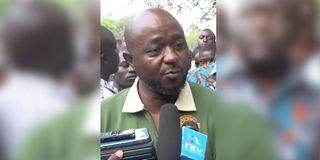
Uriri MP Mark Nyamita.
Uriri MP Mark Nyamita argues that President Ruto has shown positive gestures towards Nyanza region more than any other sitting president in Kenya since independence.
“The people of Migori and the entire Nyanza region will continue to support President Ruto because, in less than three years, he has visited Migori five times. Uhuru Kenyatta did ten years but only came to Migori once, for two hours, while Mwai Kibaki only visited once and planted a tree in Sony.” Mr Nyamita said.
He noted that it is only through the Kenya Kwanza government that Migori has realised the establishment of an Airport.
The Kenya Kwanza administration has also established market development in Nyanza region at scale. In Siaya, modern stalls are under construction in Obambo, Akala, Sio Port, Riat Kolemo, and Bar Ober at a combined value of Sh300 million.
Migori features over Sh730 million worth of multi-storey markets in towns such as Riosiri, Ranen, Sibuoche, and Ntimaru.
Homa Bay has invested more than Sh573 million in ESP markets to support small-scale traders and boost rural commerce.
Education infrastructure is also expanding. Kisumu’s Tom Mboya University is nearing the completion of Phase II (Sh1.23 billion), a seven-storey facility that will host over 10,000 students.
Junior secondary school classrooms in institutions like Maseno Mixed, Bar Union, and St. Alloys Ojolla are also underway, with each block of four classrooms costing between Sh3.8 to and Sh4 million.
Health sector investments include Homa Bay’s Sh105 million Universal Health Connectivity program and the ongoing construction of Migori’s Piny Owacho Hospital (Sh53.8 million).
Upgrades to Kisumu West’s government offices include a new DCC office block, Huduma Centre facilities, and backup power systems.
Though some initiatives remain stalled due to land disputes, contractor delays, or unclear timelines, the political goodwill between Ruto and Raila continues to offer hope that these challenges will be addressed.
As cranes rise, roads stretch across the landscape, and new markets buzz with activity, Nyanza’s long wait for inclusive development is finally bearing fruit. The rebirth is not just political—it’s now cast in concrete, steel, and bitumen.


